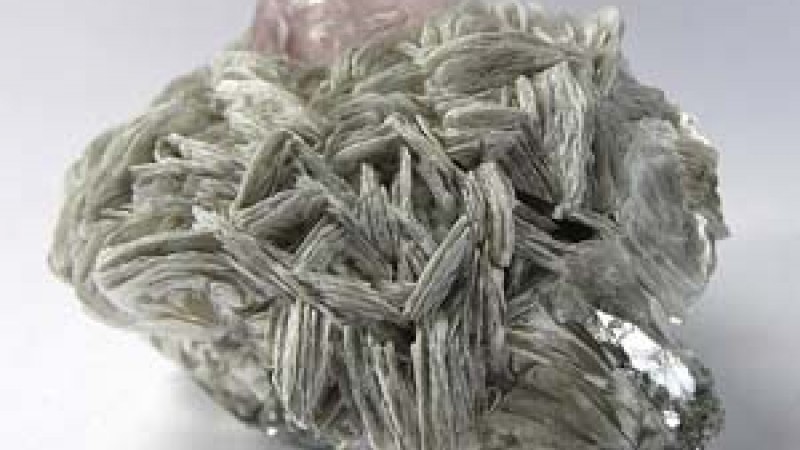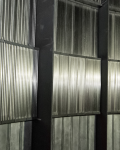The first refereed paper to be published from research done on the SEQUOIA inelastic spectrometer underscores the potential of neutron scattering for geological studies and the advantages of combining neutron measurements with computer modeling.
L’Ubomír Smrčok of the Slovak Academy of Sciences and Milan Rieder of the Czech Republic Geological Survey used SEQUOIA (the Fine-Resolution Fermi Chopper Spectrometer) to map the dynamics of hydrogen atoms in muscovite, a type of mica, and relate that information to the crystal structure. They compared the experimental findings with computer simulations of the structure and dynamics of the material, using density functional theory (DFT) calculations, to check the accuracy of the theoretical predictions. The sample measured was a natural muscovite crystal taken from a feldspar mine in the Czech Republic, rather than a crystal synthesized in the laboratory.
The experiment was conducted during the commissioning process for SEQUOIA, which is developing into a workhorse instrument for studies of dynamic processes in materials. The time-of-flight chopper spectrometer allows scientists to examine magnetic excitations and fluctuations and lattice vibrations in materials at unprecedented energies and resolution. SEQUOIA is now fully in the SNS user program.
In American Mineralologist, the scientists report that the neutron scattering run was able to map the vibrations and energies of hydrogen atoms in the structural lattice of muscovite in the energy range of 10 to 150 meV. Signatures of Al-O-H bending modes (vibrations that distort the regular polyhedral lattice structure) were found over the whole energy range but were more prominent in the 100 to 125 meV range. The data from SEQUOIA matched well with the computational calculations.
Infrared and Raman spectroscopy have been used extensively to measure hydrogen dynamics in mica, but those techniques are largely restricted to the 375 to 450 meV energy range. The vibrational modes of hydrogen are easy to measure in that range because they aren’t heavily influenced by the motions of other atoms. The lower energy range of the Al-O-H bending modes has previously been largely inaccessible to measurement because the motions of heavier atoms mask the motions of hydrogen in that region.
This experiment is part of a larger study of hydrogen behavior in mica to broaden understanding of micas as a class. There are many types of mica, and they’re an important mineral group closely related to clays. The hydrogen dynamics in them vary widely and are what make one mica different from another. Hydrogen atoms in mica don’t form strong bonds that would restrict their vibrations, so they’re easily influenced by the dynamics of atoms around them. Thus they can reveal details about the structure and dynamics of their molecular environment. The information obtained from this experiment provides good preliminary data for further studies of the less-ordered but technologically much more important sheet silicates. The overall study is fundamental research of interest to the geophysical community.
Neutron scattering is ideal for geological research because it’s particularly sensitive to hydrogen, and geological materials contain a lot of trapped hydrogen. Using SEQUOIA, the research team could study how the hydrogen–oxygen bonds vibrate by looking specifically at the hydrogen. They then combined the experimental results with the DFT calculations to see where the hydrogen atoms sit and how surrounding atoms restrict the energy of their vibrations.
Other experimental methods typically used to explore such materials, like infrared spectroscopy, don’t see hydrogen well and focus more on oxygen atoms, says Garrett Granroth, instrument scientist for SEQUOIA.
“Hydrogen is light, and it moves around [vibrates] a lot,” he explains. “Think of a bowling ball and a tennis ball attached to a rubber band. The tennis ball would bounce around a lot; the bowling ball wouldn’t move much.” Other experimental techniques see clearly only the heavier atoms, the bowling balls. Neutron scattering sees the hydrogens—the tennis balls—more clearly than other atoms and can distinguish their location and their motions in the lattice.
The vibrational energies predicted by the computer model agree well with the values measured on SEQUOIA, allowing the research team to validate and refine the modeling approach.
“It’s a very productive way to work,” Granroth says of the neutron experiment. “The total amount of time spent on SEQUOIA was no more than a day. So in very little time, they could compare their theoretical calculations to the experiment and publish something of value to the geophysical community about how the hydrogen atoms are moving around in these layered aluminosilicates.”
The team intends to follow up the muscovite study with neutron scattering experiments on other types of mica.
SNS is funded by the U.S. Department of Energy (DOE) Office of Basic Energy Sciences.
Published Work
L. Smrcok, M. Rieder, A. I. Kolesnikov, and G. Granroth, “Combined inelastic neutron scattering and solid-state density functional theory study of dynamics of hydrogen atoms in muscovite 2M1,” American Mineralologist 96, 301 (2011).






